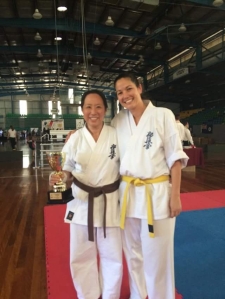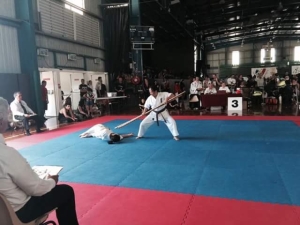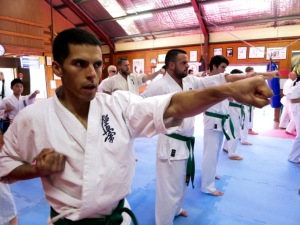Kyokushin International Martial Arts Australia had a busy and rewarding 2015. The senior grades took every opportunity to train together to advance and consolidate knowledge, while the juniors made big leaps forward in achieving individual personal goals. KIMAA had a particularly good year in tournaments at all levels: local, state, national and international.
Japan Group Tour
The year began with final preparations underway for the Japan KIMAA Tour in March. The tour group included:

- Shihan Howard Lipman
- Shihan Rick Cunningham
- Sensei Mark McFadden
- Sensei Jon Ellis
- Sempai Don Cheong
- Sempai James Campbell
- Sempai Alex Lloyd
- Patricia Tan
The tour began in Okinawa with several training sessions with Sensei Tetsuhiro Hokama (10th Dan Goju-ryu & Kobudo). Sensei Hokama and Shihan Ken Ogura ran through Kobudo (weapons), kata and self-defence with the tour group, checking their technique and assessing their grades.
Sensei Hokama was most impressed with the standard displayed, and Shihan Ogura proclaimed he had never seen an international group as proficient in Kobudo as ‘the Australian team’.
New black belt (Dan) grades in Kobudo were awarded to members of the tour group, and other KIMAA karateka not on the tour, at the recommendation of Shihan Lipman and Shihan Cunningham. Shihan Lipman, the Branch Chief of International Hokama Kobudo in Australia, was also promoted to 7th Dan, and Shihan Cunningham to 6th Dan.
A major highlight of not only the trip, but the entire year, was the 22nd Okinawan Karate Tournament in which Sempai Don and Sempai James competed. The tournament was hosted by Shihan Lipman’s old friend, Shihan Yasuhiro Shichinohe (7th Dan Kyokushin), whom KIMAA trained with in 2013. Don and James were the only international competitors at the tournament and admirably represented KIMAA. Sempai Don lost his first round while Sempai James made it to the quarter finals, finishing as one of the top eight in the Men’s Open division. Their coaches, Sensei Mark McFadden and Sensei Jon Ellis, were proud of Don’s and James’s efforts.

Some more training with Sensei Hokama and Shihan Ogura followed, as well as exploring the sights of Okinawa. A ‘Kyokushin photo shoot’ was also undertaken by the tour group!
After a final night class with Sensei Hokama, the group enjoyed sightseeing in Hiroshima and Kyoto.
Sydney, NSW
Sydney Kobudo students began the year preparing for the Japan trip. In addition to their normal Kobudo training, they also had a go at tameshigiri (trial by cutting) in January, cutting through mats with the kama and the sword, which they revisited in July.

The first major KIMAA calendar event of 2015 was held by Shihan Howard Lipman (8th Dan Kyokushin, 7th Dan Kobudo) in Sydney. The weekend seminar of May 9-10 focused on Kyokushin basics, bunkai and Kobudo. The seminar ensured that the correct technical standard was being upheld throughout all KIMAA dojos.
After the Kobudo grading in Japan in March, belts and certificates were awarded to students in May, presented by Shihan Rick Cunningham (6th Dan Kyokushin, 6th Dan Kobudo).
Following on from the performance of Sempai Don and Sempai James in Japan, students from Turramurra and Annangrove dojos got into training for the NSW Kyokushin State Championship in May. All students fought well against their opponents. Special recognition goes to James Parasyn and James Kosimar for their wins, and to Victor Sweeney for coming equal Third in his division.
As winter set in, eyes turned to the combined senior grading and seminar later in the year. Training intensified throughout KIMAA. Yudansha (black belts) from all dojos came together for a weekend of training together in August. This included Kobudo training on the Saturday afternoon, and an intensive kata session on the Sunday, both at Shihan Cunningham’s Annangrove Dojo.

Soon after the Yudansha weekend, many students from Turramurra and Annangrove competed in the IFKKA Tournament on Sunday September 6. KIMAA dominated the event, its students winning many placements and medals. KIMAA took the top three spots in the Men’s Open Middle Weight: Sempai Don Cheong (First), Sempai Ben Ng (Second) and Sempai Alex Lloyd (Third); Kasra Parsanejad came First in his division; and Andy, Elia, Christian, Jasper, Bernard and James came Second or Third in their respective divisions.
After the tournament, attention turned back to the upcoming seminar and grading. Sempai Ben and Sempai Don were rigorously training for their sandan (3rd Dan black belt).
To further their efforts, a senior kata session was held by Shihan Lipman at Turramurra Dojo. Black belts from Turramurra, Annangrove and Ballina Dojo were in attendance. Shihan Lipman and KIMAA’s technical director, Sensei Peter Olive (4th Dan Kyokushin, 1st Dan Kobudo), were satisfied that the overall technical standard of the black belts has never been higher.
The landmark weekend finally arrived, with KIMAA’s combined seminar and grading running October 30 to November 1. The karateka – from the smallest Little Lion to the adults – were hungry to prove themselves and show the results of their dedicated training.

The first night of the seminar, on a Friday, was held at Turramurra Dojo. Ray, a Krav Maga instructor, taught at Shihan Lipman’s invitation. Students were given an introduction to basic self-defence against an opponent with a gun, and an opponent with a knife. The students enjoyed learning some new skills.
The Kyokushin seminar began on Saturday morning at Annangrove Dojo. Adult and Little Lion attendees from all five KIMAA dojos, including Knox Karate, participated on the day. Kihon (basics), Sanbon Kumite (three-step sparring) and bunkai were revised extensively during the morning. In the afternoon the tameshiwari (board breaking) component of the grading was undertaken, including some impressive multi-breaks by Sempai Ben and Sempai Don, and four-board breaks with seiken (forefist) and shuto (knifehand) by Sempai Wally Gray. The day finished with fight training.
Sunday November 1 saw the senior grading take place. Sensei Peter led the class while Shihan Lipman and Shihan Cunningham assessed the students. The senior Kyu grades and black belts attempting the grading were Sempai Ben Ng, Sempai Don Cheong, Sempai Wally Gray, Josh Darley, Victor Sweeney, Patricia Tan and Jermaine Downs. During the long session, Kyu grades and black belts not grading broke up into groups for specialised training, led by Sensei Paul Finnerty (4th Dan Kyokushin, 3rd Dan Kobudo), Sensei Mark Shelmerdine (4th Dan Kyokushin, 4th Dan Kobudo), Sensei James Sidwell (4th Dan Kyokushin, 1st Dan Kobudo) and Sempai James Campbell (2nd Dan Kyokushin, 2nd Dan Kobudo).

After a hard morning, the grading was over. Congratulations are once again extended to all who participated, especially the new Dan grades: Sensei Ben Ng (3rd Dan Kyokushin), Sensei Don Cheong (3rd Dan Kyokushin) and Sempai Wally Gray (2nd Dan Kyokushin).
Essential to the success of both seminars were Shihan Cunningham’s wife Kirsti, Sensei Mark McFadden and Sensei Ian Holdaway (3rd Dan Kyokushin, 1st Dan Kobudo), who kept everyone well fed!
Sensei Don also wrote an essay on the importance of visual focus in Karate for his grading, which Shihan Lipman encourages all to read.

Regular Kyokushin training at Turramurra and Annangrove continued for the rest of the year. The final Kobudo class was held on Sunday December 20.
During the year Turramurra Dojo created its own Facebook page, which we encourage all to Like to keep up to speed with the latest updates and photos.
A new KIMAA video was also released during the year, using footage from 2014 and 2015. Thanks go Sempai Alex Lloyd (2nd Dan Kyokushin, 1st Dan Kobudo) and Jonathan Lee for the extensive photography and video work throughout the year, and all other contributors.
KIMAA students from Sydney competed in local, state and international tournaments, smashed through new personal bests in challenges such as board breaking, and raised the standard of their weapons and kata to a whole new level.
The success of Sydney students in these tournaments reflects the quality tournament training. For Turramurra and Annangrove students, particular thanks for this goes to Shihan Lipman, Shihan Cunningham, Sensei Mark Shelmerdine and Sensei James Sidwell. However, it also reflects the hard work and positive attitude of the students, many of whom only fought in their first tournament in the last two years.

Far North Coast, NSW

KIMAA students of Lismore and Ballina dojos had a busy year, particularly in tournaments.
Early in the year, three karateka from the North Coast were part of the Japan group tour. Sensei Mark McFadden (3rd Dan Kyokushin, 3rd Dan Kobudo) and Sensei Jon Ellis (3rd Dan Kyokushin, 2nd Dan Kobudo) returned to Japan to once again train with Sensei Hokama. Patricia Tan also partook in her first KIMAA trip to Japan.
Sensei Mark last went to Japan in the 2013 tour, Sensei Jon in the 2010-11 tour, and Trish last trained with Sensei Hokama in Sensei’s 2012 visit to Australia.
During this trip, Sensei Mark and Sensei Jon were graded to 3rd and 2nd Dan in Kobudo respectively, as well as coaching Sempai Don and Sempai James in the tournament.
Karateka from Lismore and Ballina trained at the May Sydney seminar, displaying an exemplary standard of technique.
The North Coast held its own seminar in July. Shihan Cunningham taught at the seminar, with Sensei Mark and Sensei Jon also leading instruction. The seminar expanded upon the bunkai work looked at in previous seminars, both in Sydney and held at Lismore. The seminar concluded with a Kobudo grading.

Little Lions and adults competed in various local, state and national competitions throughout 2015, with the National All Styles and other organisations.

For the NAS competitions, students had to complete a qualifying round before being able to enter the state competition. Students who had qualified competed in the NAS Queensland State Titles in October.
Many trophies were won, but as Sensei Mark told his students, ‘It’s not the trophies – it’s the participation, it’s overcoming the fears of getting up in front of everyone or standing up to fight someone. Osu and well done.’
In between all the tournament training, practising kata and Kobudo continued. Students regularly attended weekend classes, always geared to prepare for the next major seminar, grading or tournament, or just for regular weapons training. Sensei Mark attended the August Yudansha Training Weekend at Annangrove Dojo, and Sensei Jon flew down for the October Senior Kata Training at Turramurra Dojo.
Instructors and students from the North Coast dojos once again travelled to Sydney in October for the combined seminar and grading. Sensei Mark, Sensei Jon, Sempai Wally Gray, Jeremy Gray, Trish Tan and Ben Brady made the journey. Sempai Wally, Trish and Ben attempted the grading and performed very well in what was a long weekend. Sempai Wally received his 2nd Dan, Trish her 2nd Kyu and Ben his 3rd Kyu.

The efforts of the North Coast karateka at the NAS throughout the year culminated in the Australian Championships, held on the Gold Coast. Many students from Lismore, Ballina and Aspley competed. Trish Tan and Amanda Bolger had a particularly long day, pairing up in multiple partner demonstrations and also fought each other. In the end KIMAA had 3 Thirds, 2 Seconds and a First place in the National All Styles.
The North Coast karateka know the meaning of persistence. After a two day competition on six mats the previous weekend at the NAS, the following weekend saw Lismore and Ballina come together for a grading. Sensei Mark and Sensei Jon put the students through the ring but most came out not too battered and bruised on the other side.
Lismore and Ballina students, like their Sydney counterparts, had a strong year in tournaments. The challenge to push yourself to your own limits and be the best you can be was a driving force in the long hours of consistent training undertaken by the North Coast karateka. This mental fortitude translated into other Kyokushin pursuits, such as gradings, further developing the quality of martial artists from Sensei Mark’s and Sensei Jon’s dojos.

Brisbane, QLD

Students of Aspley Dojo continued to develop their kata and bunkai knowledge through internal competitions, particularly among the Aspley Little Lions. Under the instruction of Sempai Rob James (2nd Dan Kyokushin) they also continued their rigorous tournament training, with competition participation at an all-time high from KIMAA’s only Brisbane dojo.
The first major competition Sempai Rob’s students competed in was the Queensland IKO State Titles in April. KIMAA walked away with three medals.
Sempai Rob was ‘extremely proud’ of all of his students, ‘not just the ones who came away with a medal. You all worked hard on the day and displayed great spirit and determination.’
Students of Aspley Dojo continued to build a strong relationship with the students of Lismore and Ballina dojos throughout 2015. Sempai Rob and students teamed up with the North Coast for training weekends, competitions and seminars, including the North Coast July Seminar. Queensland karateka also made their way to Sydney for the May seminar.

Sempai Rob came back to Sydney for the Yudansha Training Weekend in August.
Aspley Dojo’s next major outing was at the NAS Queensland State Titles.
Amanda Bolger paired with Patricia Tan from Lismore for a partnership entry in two demonstration events: Creative Weaponry Demo and Creative Form Demo.
Amanda and Trish demonstrated their proficiency in Kobudo, coming First in both categories. Amanda also placed Second in her Points Sparring division and Fourth in Individual Kata.
The young Aspley Little Lion Jack Bolger also did his dojo and instructor proud. Jack represented KIMAA by competing in the Continuous Sparring 7-9 Years. Jack was eliminated in the first round, but he returned to fight in the Points Sparring 8-9 Years. He won one round. This was Jack’s first tournament and he exhibited excellent character and endurance to face up after a loss and keep pushing. Jack is one of many of Sempai Rob’s budding young martial artists.
By the end of October, it was time for the Queensland crew to return to Sydney for another KIMAA event, the seminar and grading. Jermaine Downs, Hieu Hoang and Chris Mitchell came to attempt the grading, and of course Sempai Rob came to support his students and partake in the seminar. They all passed the grading and advanced to their next Kyu grade, which for Jermaine is 2nd Kyu (brown belt).

In November, Aspley Dojo enjoyed hosting Shihan Lipman for a weekend seminar. Shihan Lipman and his wife Masumi travelled to Brisbane for the weekend. It was Shihan Lipman’s inaugural trip to Aspley Dojo.

Shihan conducted several sessions with the adults and Little Lions, focusing on basics, ido geiko, kata and self-defence techniques. For the students who had not had the opportunity to travel to Sydney before, it was a great experience to be taught by Shihan Lipman.
KIMAA’s head instructor emphasised to all the meaning of Kyokushin, the pursuit of the ultimate truth, and doing so as per the teachings Shihan learned from Sosai Oyama.
‘Aspley has had a very successful year, going from strength to strength. Students’ knowledge is improving as is their technical ability, and the support I receive from both adult students and parents of the Little Lions is humbling. I believe in building the people before the dojo and, as a result, we have a solid core of students both in the Adults and Little Lions who work hard and have a positive “can-do” attitude.’ – Sempai Rob James on 2015 for Aspley Dojo.
The quality of Sempai Rob’s instruction is reflected in the strength of a young dojo, a dojo that is a firm part of the KIMAA family.
Closing Remarks

2015 was undoubtedly a triumph of a year for Kyokushin International Martial Arts Australia. Success in all tournament levels, new highs in Kobudo, sharper kata and a deepened knowledge of bunkai continue to develop among KIMAA’s martial artists, regardless of age or gender. Everyone saw the challenges their fellow students were setting themselves – gradings, tournaments, overseas trips – and aspired to improve themselves, emulating their peers, and achieved just that. Well done to all KIMAA students on a terrific year.
Our thanks goes, as always, to the dojo operators and other instructors who set the tone and culture of KIMAA, maintaining a competitive but friendly learning environment where each student is challenged to do their best. Shihan Lipman, Shihan Cunningham, Sensei Mark, Sensei Jon and Sempai Rob run dojos of which every student is delighted to be a part.
Enjoy the holiday season and see you all in 2016. Osu!






























































































































































































